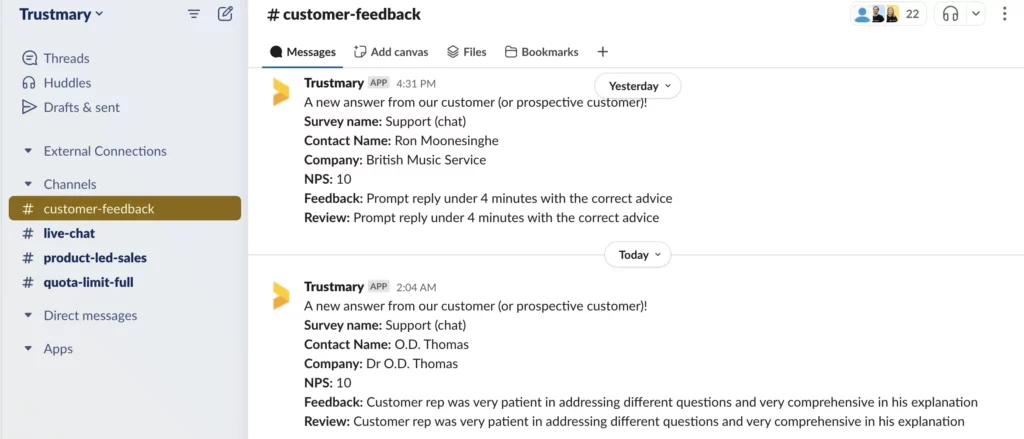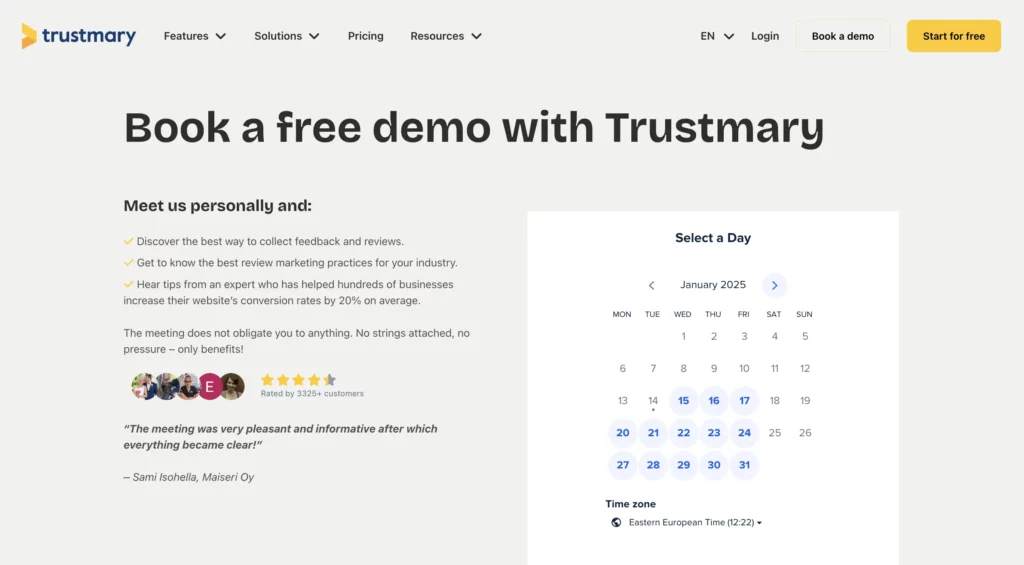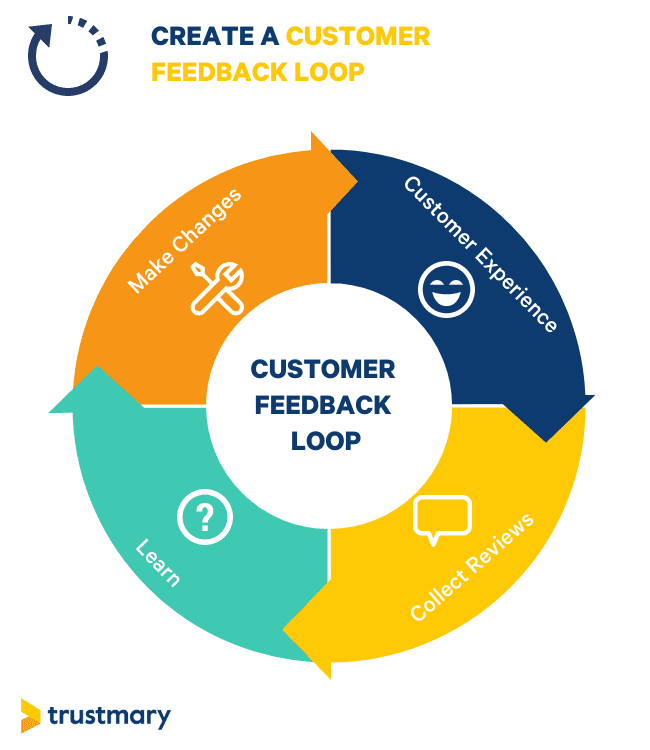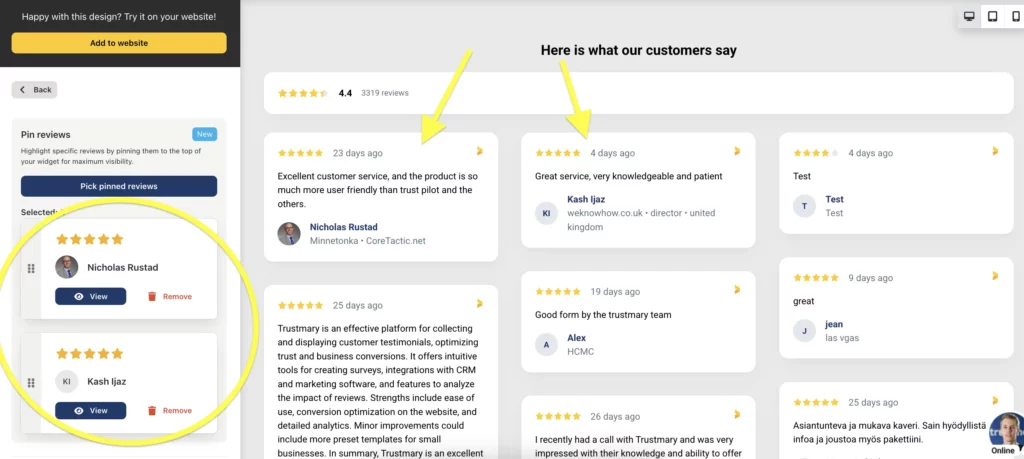How to Share Customer Feedback with Employees?


Sharing customer feedback internally is the easiest way to make customer satisfaction a top priority company-wide and a motivator for all employees.
Making sure customers are happy isn't just a task for the customer facing teams, but for the whole organization. That's something my role as Product Manager and being one of the co-founders has taught me the hard way.
A real-life example of the importance of sharing customer feedback internally: In 2020, we at Trustmary started to share all customer feedback on our Slack channel with a Zapier integration. It took less than a minute to set up, but the impacts of it have been monumental.
Now, our product team is just as aware of the current state of customer satisfaction as all our customer-facing teams, like our customer success team. Just setting up this open feedback system has been a key factor in enabling our speedy growth. Furthermore, now everyone knows that the decisions on our product roadmap are made based on what customers want.

If the real-life story wasn't enough to convince you to share all feedback internally with the entire company, here is a list of the biggest benefits. After those, I'll go over how to set up a customer feedback process to get feedback to share.
Benefits of Sharing All Feedback Internally
These are based off of my experience of openly sharing all customer feedback for five years.
- Enhance employee engagement
- Close communication gaps between teams
- Make everyone's work visible
- Improve customer understanding
- Help make strategic decisions within teams
- Know what customers love
All in all, being truly customer-centric helps the whole company feel more united when they have a common goal: Making sure customer needs are met, and customer are happy.
Seidat also shares product feedback internally and the company benefits from everyone from sales to development team to know what customer love – and what they don't.
Balkonser shares a monthly customer feedback report with all employees to read. The benefit lies in making everyone aware that customer experience is built based on sometimes the smallest details, like taking shoes off when entering a home.
Best Practices for Sharing Customer Feedback
Customer loyalty is easily lost, but hard to build and maintain. Collecting feedback and reviews, plus sharing that with internal stakeholders is key.
It's important for me that all my colleagues must know what customers think. This is one of your company's values: Being customer-centric and building a product users love.
Let's go over my tips for the most optimal way to share customer feedback in real time.
Measure Customer Experience 24/7
To get valuable customer insights, you need to get customers to submit feedback.
The best (and only scalable) way to collect customer feedback is to ask for it.
Ask for feedback after key customer conversations, such as meetings, after help chat interactions, or after closing a deal.
Don't let anyone feel unheard. It's better to ask too much than not at all.
Trust me, customers will tell you when you're bothering them. Another great indicator is a significant drop in the average survey response rate.
Automate the Sharing Process
Share customer feedback where employees need minimal effort to access it.
In our case, that meant setting up an integration from the customer feedback system to Slack using Zapier.
All the positive reviews fly into our customer feedback channel in real time. No one has to log into another service to read product feedback or how someone's meeting went.
Setting up automation is a great way to expose everyone to great and not-so-great feedback. Make sharing customer feedback a process. Not a one-off thing.
Recognize and Reward Employees
The great thing about measuring customer happiness is that each team will pay close attention to what customers are saying about them.
Our sales team sends a survey after each first meeting they have with a new prospective customer. The feedback helps our sales team members do better in the future and make sure they provide value for everyone they meet.
Additionally, the feedback is added to our book a demo page to convince more people to book a call with our great sales team.

This makes the work of the team really visible for both internally and externally.
Similarly, Trustmary's customer Eezy Personnel has used NPS as a way to measure the performance of their teams. The employees are also rewarded based on how happy the customers have been.
Share Feedback Publicly
Before you share customer feedback publicly, make sure the customer in question is okay with you doing so.
Share the good work an entire team or an individual has done to social media and newsletters. This might even encourage more and more customers to leave qualitative feedback.
Social media posts that feature customer feedback tend to work very well without sounding too sales-y. If you tag your customer, they might even share it with their network! A real win-win scenario.

Get Internal Product Feedback
The easiest way to get actionable feedback is to get internal feedback for all new features, product improvement, and UX changes. If your team struggles to understand them, there's a high chance customers will be even more confused.
After all, your team spends the majority of their time with your solution, but even happy customers might only use it a few times a week.
I think collecting internal product feedback with surveys, internal discovery calls, and generally during company-wide meetings has helped us create an even better product.
I'd recommend everyone to set up an internal feedback process to have a continuous dialogue between your different teams. Especially between customer facing teams and the product team.
One critical rule in asking for internal feedback is to not get offended by it, but embrace it and thank for the feedback. Don't start explaining and defending your POV, just thank people for their valuable insights.
You can always cry in a corner about it later in private.
Customer Feedback Loop
It's actually quite easy to create a feedback loop.

Here's what I'd recommend everyone to do:
- Identify key customer feedback points
- Send satisfaction surveys after the touchpoint (Add follow-ups for non-responders!)
- Fix what's broken based on the insights in open feedback
- Follow-ups: Express appreciation for feedback, share with team members
A customer feedback loop is easily automated with Trustmary, if you have a CRM or ERP system in place. Just saying.
You can automate customer feedback collection even without a CRM by choosing Trustmary.
Product Strategy and Customer Feedback
Customer feedback tools are great for getting product feedback. As a product manager, here are some key ways new customer feedback influences our product roadmap and product strategy.
- New feature requests through insights
- Actionable insights on what works
- Improvement ideas for product development plans
- Improvements to usability
Ideas to Product Roadmap Flow
- Ideas are added to a Slack channel
- A ticket is automatically created to Productlane
- Tickets are processed manually
- Tasks are created to Linear
- Tasks are prioritized and assigned to the product team
Thanks to implementing this process that captures the voice of customer at every turn, we've been able to narrow down a few tiny tweaks we need to make to smoothen out the user experience.
Real Life Example – User Feedback Influences Product Roadmap
To improve user experience by eliminating small annoyances, we launched the "papercut project". I went over all the issues in out Productlane and looked for the most commonly mentioned ones.
One of the most ofter requested features in 2024 was pinning reviews in a widget. I got added to the papercut sprint project. Getting it done didn't take too long and the response from users has been great. Customers feel heard as their wishes were fulfilled.

In the papercut project we also added a few other minor improvements and new features that didn't require weeks of work.
Getting Customer Feedback Across Different Channels
There are a few different channels to consider if you want to capture all external feedback.
Product Development Ideas Slack Channel
As we have a few customer facing teams, all of my colleagues write customer insights from meetings to our product-development-ideas Slack channel.
In addition, anyone can at any time write a new idea they had about new features we should add.
Fun fact: the Slack channel had over 6.000 messages in 2024.
Each thread is connected to Productlane where I can then easily prioritize new ideas for development.
Benefits of Asking for Feedback
- Customers feel heard
- Regular communication isn't focused on feature requests, but on looking at the bigger picture
- Customer support isn't over-worked
- Employees feel seen
- Internal stakeholders know customers better
- Customer experience becomes better
- Online reviews are more positive
Stop Guessing – Collect Customer Feedback
Now you know about what a feedback loop is, how to start collecting feedback from customers, how to get internal feedback, and product feedback.
In addition, you know how to share customer feedback with employees and why you should do that. To summarize, you understand what a customer feedback strategy contains.
If you need help setting up the processes, we can help!